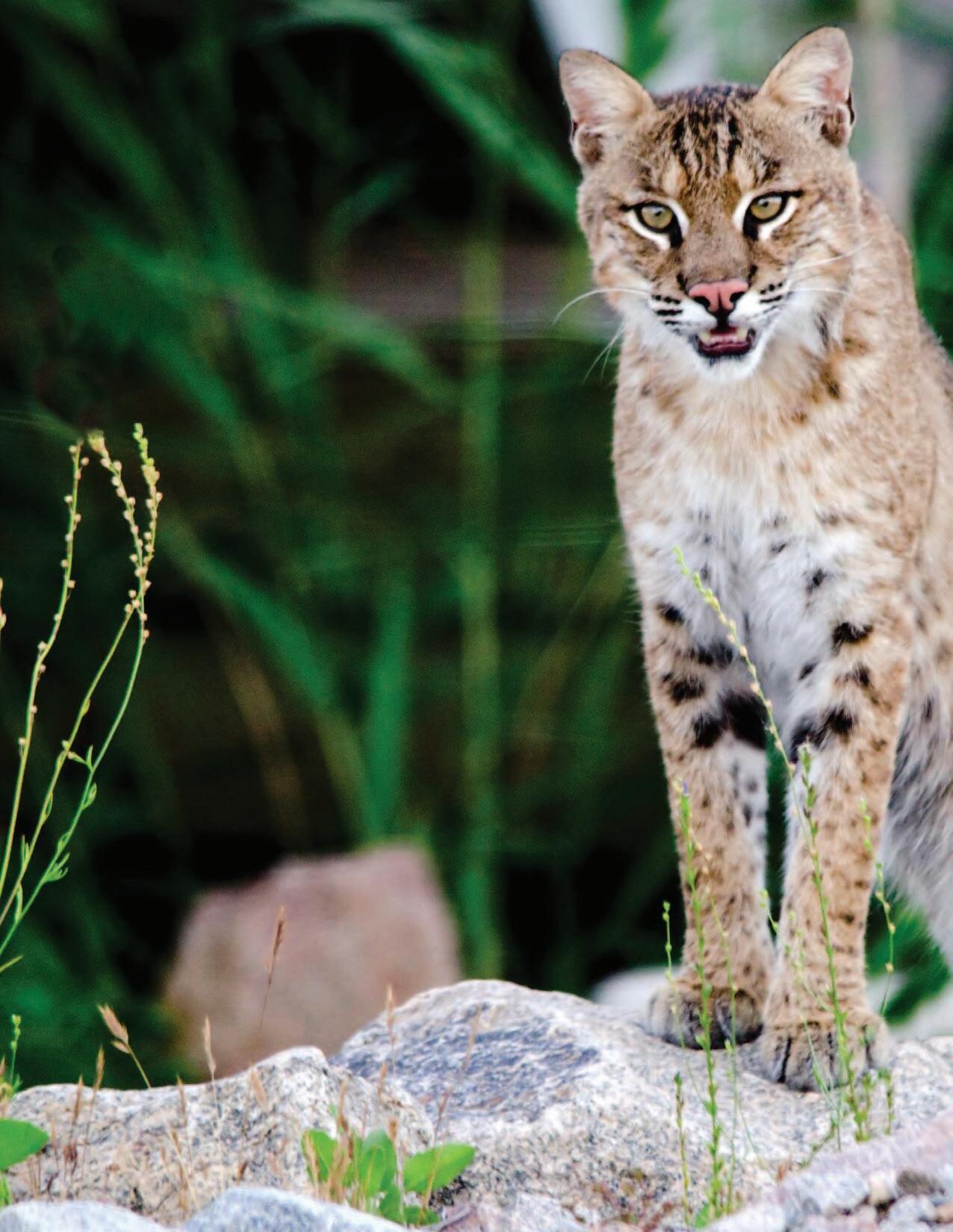
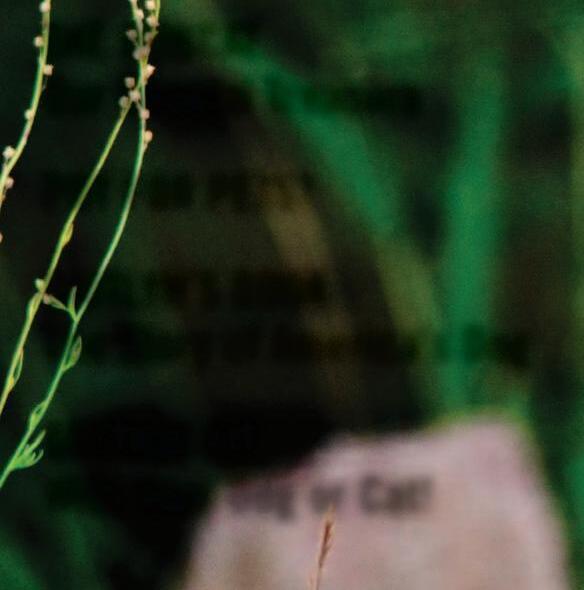
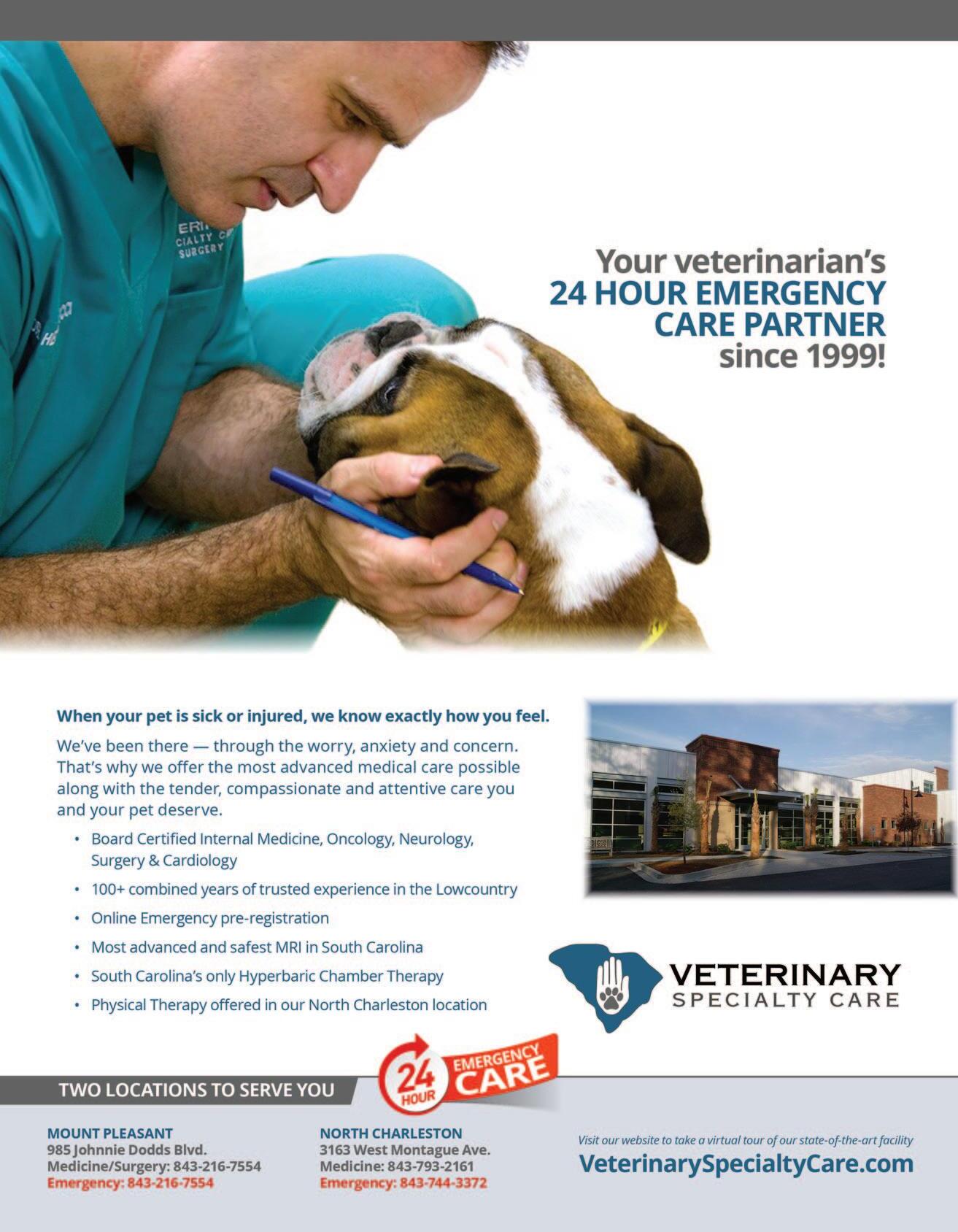
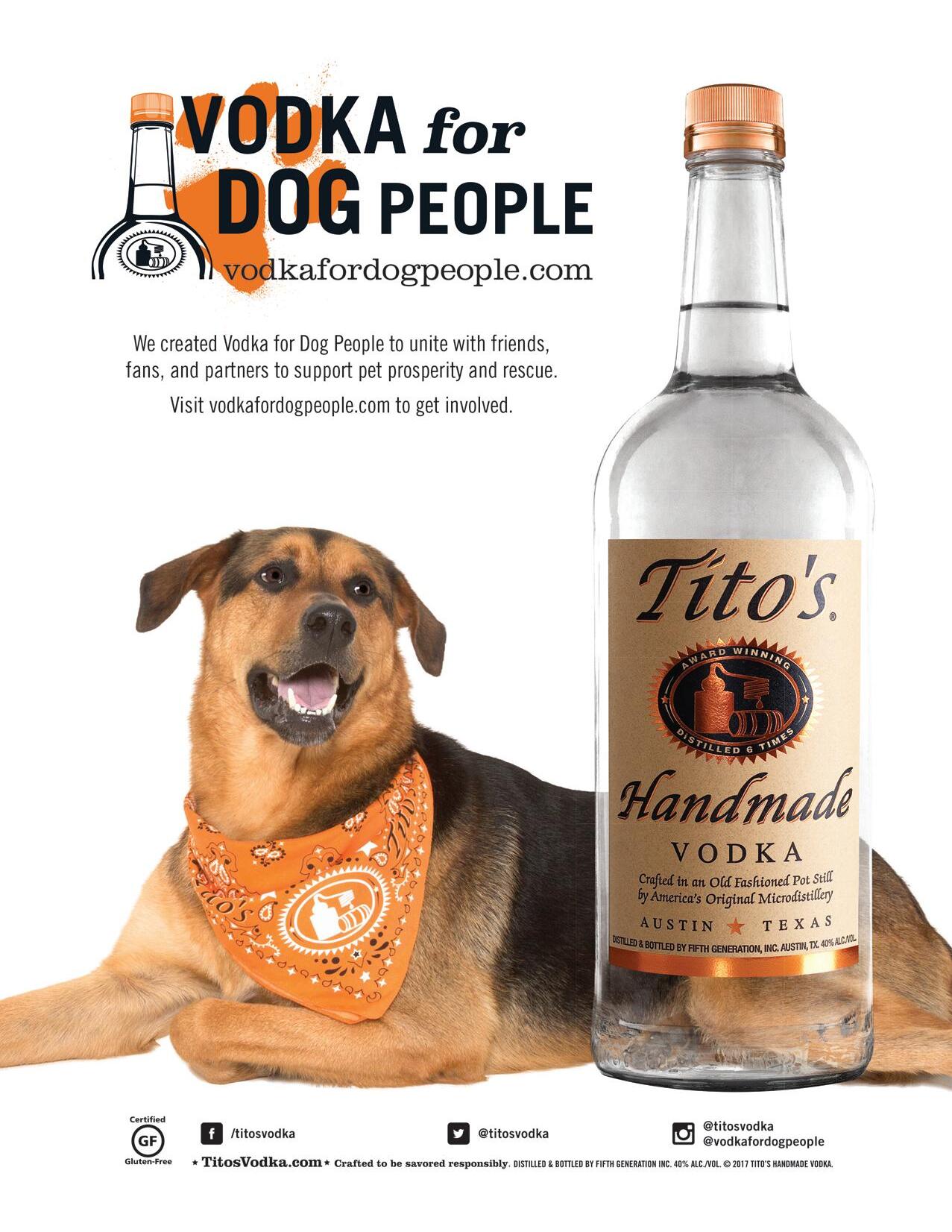


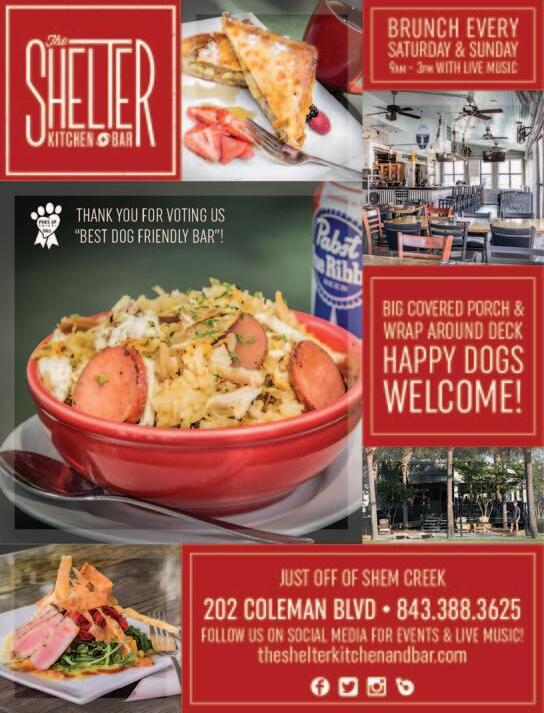
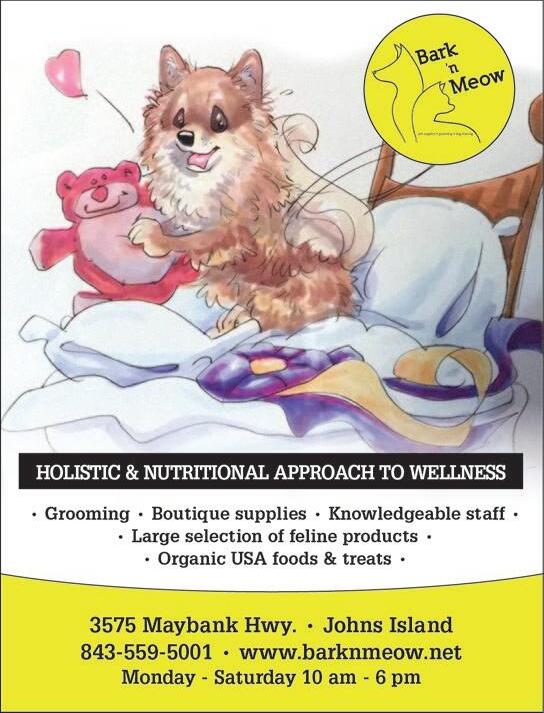











Publisher: Keith Simmons
Editor-in-Chief: Dan Krosse
Managing Editor: Joe Elmore
Graphic Design: Heineman Design
Assistant Editor: Teri Errico Griffis
Writers: Dan Krosse, Helen Ravenel Hammond, Ellie Whitcomb Payne, Teri Errico Griffis, Sarah Humlie, Dean Olcott
Photographers: Jeanne Taylor, Marie Rodriguez, Ellie Whitcomb Payne, Matt Chan, Charles Merry
Advertising Sales: Ted DeLoach
For inquiries regarding advertising, distribution or suggestions in Carolina Tails call (843) 410-2577 or ksimmons@charlestonanimalsociety.org.
2455 Remount Road, North Charleston, SC 29406 (843) 747-4849 www.CarolinaTails.org
President: Hank Greer
Vice President: Helen Pratt-Thomas
Secretary: Aussie Geer
Treasurer: Laurel Greer
Members
Chief

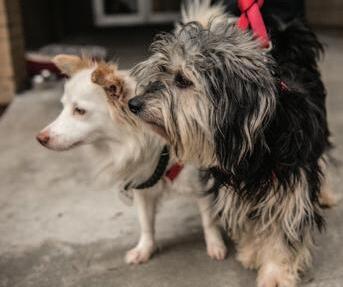


With the New Year upon us, it is always encouraging to me how so many of us brim with optimism about what lies ahead. With this in mind, I think you will find it interesting to read our article about the future of Charleston Animal Society on page 18. The new strategic plan being developed will serve as a road map for us to the year 2023. What will Charleston Animal Society look like in the future? It is an exciting question filled with possibilities.
Along this line we have dedicated a section in the front of our magazine called “New Year, New You” (pg. 10). It is filled with ideas to help keep us all motivated in 2018 to achieve financial success, better relationships, happiness, and fitness – all this with our pets in mind.
The Bobcat is a true coastal jewel that deserves all of our efforts to protect. Laurel and I are blessed to live on Seabrook Island -- a virtual nature preserve with houses tucked inside. Living there, we have been afforded the opportunity to take some incredible photos of Bobcats that come visit on a regular basis. One of those photos grace our cover and don’t miss the rest on pages 16 and 17.

As usual, the writers of Carolina Tails never cease to amaze me and this issue is no exception. Inside you will find an article on the growing use of marijuana for our pets (pg. 22)! Who would have thought in my lifetime we'd see this medical treatment as a possibility? But not all veterinarians are on board yet. It's a great read.
Way back in the day right after World War I, there was a dog who was bigger than any celebrity on the planet and his name was Sergeant Stubby (pg. 26). Well, this spring an animated movie is coming out about him and we have a wonderful preview. What’s fascinating about Sgt. Stubby is that he is a Pit Bull type of dog and one that is decorated by the U.S. military for his bravery on the front lines.
I want to leave you with a milestone that Charleston Animal Society will be celebrating in 2018 – five years of keeping Charleston a No Kill Community! For those of us like myself who have dedicated much of our lives to animal welfare, this achievement in 2013 was as close to a miracle as I’ve ever witnessed. Many public shelters around the country are still euthanizing 7 out of 10 animals that come in their doors. Here, thanks to the leadership of Charleston Animal Society, our community is able to save 9 of every 10 animals, and none are euthanized because of space. We are still the only No Kill Community in our state, which is why we have launched No Kill South Carolina to help other communities in our state become No Kill.
Making Charleston a No Kill Community became possible by following lifesaving strategies enhanced and introduced to us by the ASPCA. Among the strategies are innovative and best practice adoption tactics, advance treatment for injured and ill animals, a community-wide free roaming cat initiative, an expanded foster family network and a high volume, high quality spay-neuter program. These are strategies that worked and ones we continue to follow.
But an even larger component of the success of No Kill Charleston was YOU! It was your belief and the continuing gifts of your time, your homes and your money that make Charleston a beacon of light for animals in the Southeast. Cheers to health and happiness in 2018 for you and your families, including all the furry members.
Sincerely,

Hank Greer President CHARLESTON ANIMAL SOCIETY


Second-grade students who read aloud to dogs in an afterschool program demonstrated improved attitudes about reading, according to researchers at Tufts Institute for Human-Animal Interaction.
Reading skills are often associated with improved academic performance and positive attitudes about school in children. Researchers wanted to learn if animal-assisted intervention in the form of reading aloud to dogs in a classroom setting could contribute to improved skills and attitudes.
Researchers divided children into two groups. For six weeks, one group read to a therapy dog for 30 minutes once a week; a control group followed a standard classroom curriculum. Children’s reading skills were assessed biweekly and attitudes about reading were assessed pre- and post-intervention.
Scores assessing academic reading attitudes increased significantly among the children who read aloud to dogs. Reading skill scores did not change significantly in either group, nor did attitudes about recreational reading outside of school.
“Our results suggest that reading to dogs in an academic setting has the potential to provide motivation, which will help inform future research into this animal-assisted intervention,” said the study’s senior author Lisa Freeman, D.V.M, Ph.D. Charleston Animal Society’s Humane Education program offers a chance for children to read to animals. Learn more at www.CharlestonAnimalSociety.org/Education.

In October, Thor was doing his job as a Mt. Pleasant Police K9, when he was punched in the snout by a man being arrested for car break-ins. It all went down in the marsh near Shem Creek, where a suspect was hiding. Thor found him and that’s when the man punched the dog.
Thor got the last word and bit the suspect’s arm, allowing police to cuff the suspect and place him under arrest. Earlier in the chase, a different suspect tried to run over Thor and a fellow police officer. Initially, charges of assault and attempted murder were leveled against the suspects on behalf of Thor and the police officer, but those charges were later dropped. As police spokesman Chip Googe said, "The Mount Pleasant Police Department thinks of our K9 officers just like we do every sworn officer.”
We want to know what you think:
Should Suspects Who Hit Police Dogs Face Assault Charges? Vote in our online poll at www.CarolinaTails.org
Mt. Pleasant Police K9 Thor was punched in the nose last fall. Assault charges were considered in the case against the robbery suspect who punched him.
Making history! When Charleston Animal Society led Charleston County to become the first No Kill Community in the Southeast and one of only a few in the nation, it did so with focus, strategy and determination. Launched in 2013, No Kill Charleston 2015® was deemed impossible by many, including many animal welfare experts. 2018 will mark the 5th anniversary of No Kill Charleston®, and YOU are why this celebration is possible. Charleston Animal Society is the final hope for over 90% of the animals in our community. For 144 years, the Animal Society has never turned an animal away. This is why Charleston Animal Society is so critical to the community and why YOU are vital to its success. No Kill Charleston® prompted the launch of a bolder Charleston Animal Society initiative, No Kill South Carolina®, to build the first No Kill state in the South. Together, they form our movement – No Kill. No Harm. No More. This has been no easy endeavor! Since becoming the Southeast’s first No Kill Community five years ago, 85,000 animals have been helped through your support of Charleston Animal Society.

When the Petco Foundation asked for pet adoption stories from around the country, Gil Grooms of Hanahan decided he would share his story of adopting Chloe, a special yellow lab who entered his life, just before tragedy would strike his family. “I truly believe that God put Chloe in my life for a reason. She has become so much more than just a pet,” Grooms said.
Gil met Chloe at the 2016 Charleston Animal Society Chili Cook-off & Oyster Roast. She is a beautiful yellow lab who won his heart instantly. While at the cook-off, Gil texted his 23-year-old son Zachary to see if he should get Chloe and Zach gave an enthusiastic thumbsup! But the excitement turned to overwhelming sadness three weeks later, when police say Zachary was killed by a drunk driver.
In his story, Gil spoke about Chloe being the one thing in his life that helped keep him going. Grooms says he wanted to share his story to show that the work Charleston Animal Society does, not only saves animals, but lifts the lives of families who adopt these loving, compassionate pets. Carolina Tails first shared Gil’s story in the Summer 2017 issue. You can see a video as well at CarolinaTails.org.
On December 4, the Petco Foundation awarded Charleston Animal Society $50,000 because of Gil’s story. In total, the Holiday Wishes campaign awarded $765,000 in grants nationwide.

Intake is one of the most challenging areas to work in at an animal shelter. This is the place where people bring their animals in to “surrender.” That means, they are giving their animals over to the shelter to find new homes. Watching these surrenders unfold can be gut wrenching, because of the emotions involved with giving up an animal. Between November 2016 and November 2017, 742 animals were surrendered by families to Charleston Animal Society.
“We are not judgmental when people come in, but we do offer solutions to some of the most common challenges animal owners face,” said Charleston Animal Society Lead Animal Resource Center Specialist Ashley Greaves. “Whenever we can find a way to keep an animal out of the shelter, and in a home, that is always the best solution.”
Another place to turn for the public is the Animal Resource Center on the Charleston Animal Society website. It is chock full of solutions to some of the most common issues that pop up with pets. Supporters of the Animal Resource Center have included the Banfield Foundation, the Employees Community Fund of Boeing, the Henry & Sylvia Yaschik Foundation, the ASPCA and the Mary Seibert Charitable Trust. You can find the Animal Resource Center at www.CharlestonAnimalSociety.org/getpethelp



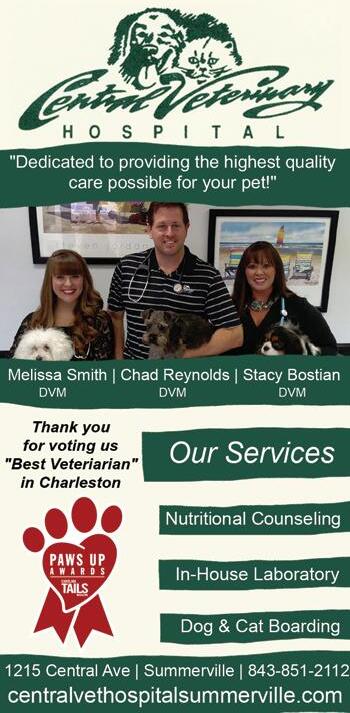


BY TERI ERRICO GRIFFIS
Come the new year, everyone’s goals are to be healthier, happier and make better choices with their money. But a good financial plan isn’t just about setting a budget number and trying to stick to it. Financial Advisor Michael E. Lewis II has some tips on how you can create a (realistic) budget, stick to it, and reminds you not to forget about your pets through it all!
“My biggest tip is always start with your goals. Most people go straight to tactics and strategies and skip the part about what they actually want to accomplish,” says Lewis, CLU, CFP, Financial Advisor for Northwestern Mutual on Calhoun St. “Prioritize your goals and make sure any strategies are in alignment with those goals. You want your life plan to dictate your financial plan, and too often people have it the other way around.”
Lewis also recommends getting professional assistance. “There’s plenty of apps and things out there, but don’t overcomplicate it,” he adds. “Step one is just understanding your cash flow—what is being directly deposited into your bank account and then where you’re spending money. Separate those expenses into your ‘have to’ and your ‘want to’ just because you enjoy it expenses.” When it comes to those ‘have to’ expenses or the monthly fixed expenses, always include savings. That and “fun” are the two things Lewis finds people don’t account for most.
While people always think about their future—and rarely ever forget to budget for their pet’s monthly expenses of dog food, dog
sitter or monthly medication—“very often they forget to address what happens to the pet if something happens to me,” Lewis says.
To assist pet owners in that future planning, Charleston Animal Society has begun The Surviving Pet Care Program. “We’re offering people reassurance that their pet will be cared for when they pass away,” says Jennifer Winchester, Director of Philanthropy at the shelter. “We will agree to take the animal in when the owner passes away and rehome them.”
There’s a $5,000 fee per animal (cat or dog, and currently only South Carolinians), which can be a single payment or a bequest in the will, and will help cover the costs of picking up the pet, caring for it (including any medication) and rehoming it. One reason for starting the program is because pet owners assume a family member or close friend will want the pet, and many times, that assumption proves wrong and pets end up being surrendered.
Winchester notes the plan doesn’t mean a pet will live out its days at the shelter. “We’re very clear that if we get them, we’ll rehome them and try to put them with somebody in their circle first,” she says. If that doesn’t work, then the animal will be adopted through Charleston Animal Society’s regular adoption procedure.
The goal of Surviving Pet Care is to offer pet owners peace of mind and Charleston residents are already committing to the program. “Pets are members of the family too, and any given day could be your last so it’s important to be prepared,” Winchester says. To learn more, contact Jennifer Winchester at: (843) 3291541 or jwinchester@charlestonanimalsociety.org.


TBY DAN KROSSE
hey’re everywhere we go. You can’t miss the glow. The beeps. The chirps. The ringtones. And for many of us, leaving the room without our cellphone is enough to induce nervous sweats, shakes and anxiety.
We love our phones, but are any of us thinking about what the virtual world is costing us in the real world? Is technology pulling us farther away from each other with each google search, facebook post or tweet we’re making in the presence of a loved one? Look at the picture accompanying this article. Who hasn’t seen a table filled with people where no one is interacting with each other –just their cell phones?
When it comes to our pets – are we really there on those walks, if we’re talking on the phone, texting and catching up on CNN Breaking News? I’m working on leaving my phone at home when I take my dog for a walk. It’s more difficult than it sounds, and I should make it a New Year’s Resolution. But I think the effort is worth it. I remember those phone-less walks much more than the ones where I’m taking my Pixel-2 with me.
An article in Psychology Today shared a study where, “researchers found that the mere presence of a mobile phone is enough to diminish relationship quality.” The researchers discovered that you don’t even have to be on the phone; just its presence is a malevolent third wheel that is sucking the soul out of your personal interactions. I would bet – even with your pets.
The researchers discovered that you don’t even have to be on the phone; just its presence is a malevolent third wheel that is sucking the soul out of your personal interactions.
All this got me thinking about a toast my nephew Doug made at his brother’s wedding. He wrapped up a fantastic speech with three pieces of advice from the couple’s dog “Little Man.” I would challenge each of us to follow Little Man’s advice with our loved ones and our pets in 2018, to improve our relationships and to help us be more present:
1. Get really, really, really excited when your spouse comes home and act like you haven't seen them in years, even though they’ve only been gone for an hour.
2. Enjoy all of life's long walks, especially when there is a beautiful fountain at the end, even if you don't know exactly what that fountain might look like.
3. Whether it's on the coldest winter night, or the hottest summer day, figure out how to put your paw or your wet nose on the other person to let them know you are always there for them, in good times and in tough times.
BY DEAN OLCOTT
Editor’s Note: By day, Dean Olcott is a surgery assistant in the Sam Greer Spay Neuter Clinic at Charleston Animal Society. But one of his other passions is keeping healthy by working out. This former fitness trainer put together a few exercises that will help you and your pet look great in 2018!

When doing a “Barkin' Burpee,” have your dog go into the “down” position as you do your push-up.
Barkin’ Burpees
Burpees are a favorite from boot camp to CrossFit. Start in a standing position. Drop and do a push-up. Then jump to your feet, keeping your hands held high. Repeat—but in this version, when you drop for your push-up, have your dog go into “down” position with you. He’ll have fun. You’ll be exhausted. And he will love watching every second.
Cat Squats
This exercise is great for your core, as well as your arms and shoulders. Make sure you cat is game before starting! Begin by holding your cat with your arms extended out in front of you. Lower into a squat position, keeping your arms straight out in front. Come back up. Repeat. If your cat gets restless, give her a break, then do another set of 5!
The Big Three: Swimming, Hiking and Running
1. Swimming is arguably the best way to keep fit for you and man's best friend because it has virtually zero impact on you or your dog’s joints.
2. Hiking is another great way to stay fit for both you and your best buddy. Be sure to scope out the trail before heading out. I recommend a harness over a leash for an even distribution of weight.
3. Most people share the same feelings about running: it’s miserable! But one way to keep things interesting is to race. I often take my Carolina Dog to an open soccer field and run 50-yard wind sprints with him (spoiler alert: I don't win very often).
With all these exercises, be sure to set goals. Maybe increase by one or two repetitions each time you go out. But most importantly, stick with it and remember it will all pay off—for you and your furry friend.
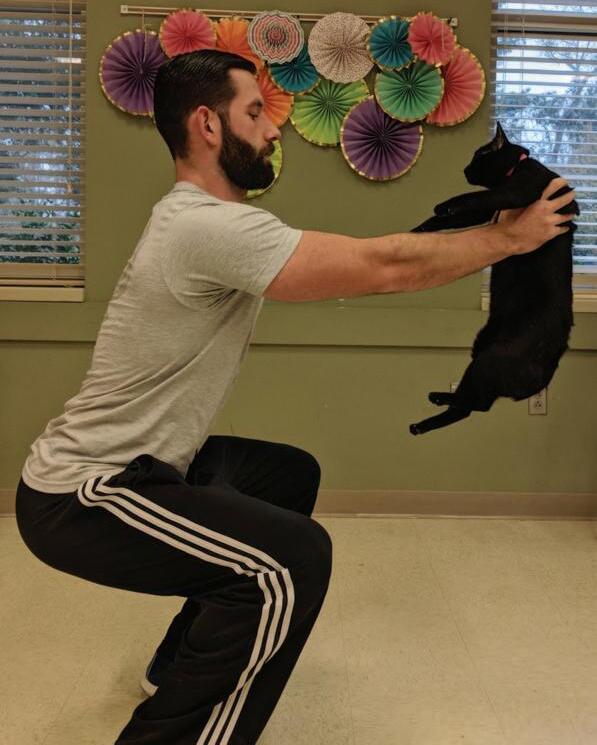

BY TERI ERRICO GRIFFIS


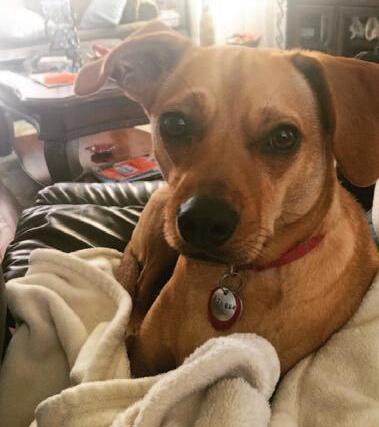
They say if you want puppy love, get a puppy, and that’s exactly what Alicia Duffany did. After a tough year that left her unsettled, unsure and a little bit lonely, her life was turned around by rescuing someone else—a puppy named Ginger.
“I was battling a lot of different emotions last year. I had gone through a bad break up, I wasn’t sure what my next move was and if I wanted to move back up North, and I was about to be kicked out of my apartment due to foundation issues,” the Goose Creek resident recalled. “I was just feeling completely unsettled.”
Looking for something fulfilling to do, Duffany and her mom decided to volunteer at a local animal shelter. “When we arrived, it turns out a huge group had just come in so there wasn’t much work to do—so we were told to just play with the dogs!” Duffany says. The first dog she interacted with was a pup with red hair, just like her. She nicknamed her Ginger. “My life was crazy and the last thing I needed on paper was a dog, but my mom kept saying, ‘Ginger’s choosing you. Look at how she’s following you around.’ And I knew just then this was the answer.”
Duffany had been thinking about adopting a dog for a while by then, but was always waiting for the right time—to be in the right place with the right finances and the right everything. But maybe waiting for the perfect moment wasn’t what she needed. As unplanned as it was, that day Duffany adopted Ginger. “While a part of me thought, ‘Oh gosh, what did I just do?’” she remembers the drive home with a laugh, “every other part of me shouted, ‘This is awesome!’”
A year later, it just keeps getting better. There’s a change in Duffany, a constant smile, a sense of purpose, a peace. “Adopting Ginger helped me find focus, and also helped me channel this

restless energy I didn’t know what to do with before,” she says. “Now I have a little partner in crime to go exploring with. I visit new parts of town with her, go on walks and venture into the dog park world. It helped me have an outlet for that little bit of loneliness you can feel sometimes. And it’s the most wonderful feeling to come home and have someone who loves you unconditionally just waiting at the door.”
Adopting Ginger also helped Duffany, who works more than 40 hours a week at the Lowcountry Food Bank, find a healthy worklife balance. “When you have someone you’re caring for, someone that depends on you to come home, you have to take that break and go focus on them,” she says. “There’s a factor of self-care, too. After a really stressful day, I’d come home beat and just want to do nothing. But I see that Ginger wants to go for a walk and it forces me to get up and do something positive. A walk with her relieves that stress and I end up feeling so much better in the end.”
Duffany fully believes that she found happiness last February when she adopted Ginger. “She fills that void and gives me a sense of purpose, something to look forward to. I love my little buddy and it makes me feel amazing knowing she loves me unconditionally too.”

BY DAN KROSSE
IT’S HARD TO BELIEVE WE’RE TALKING about summer camps in the dead of winter! But when sign-up begins for Charleston Animal Society’s award-winning summer camp program on February 1, they fill up fast—really fast!
“Fifty percent of the camps are filled before spring break rolls around,” says Charleston Animal Society Senior Director of Humane Education De Daltorio. “Not only did our camps fill up, we had a waiting list of 186 children!” This year’s offerings will include camps named “Cats Only,” “Arts & Animals ,” “Raining Cats & Dogs,” plus beginning, intermediate and advanced “Vet Camps.” Remember to sign-up at CharlestonAnimalSociety.org/SummerCamps starting February 1.
Charleston Animal Society’s programs were named “Best Day Camps” in the Charleston Choice Awards hosted by the Post and Courier. To get you thinking about Summer Camp, here are some hilarious things our summer camp staff overheard the kids say this past summer:
KIDS SAY THE DARNDEST THINGS!
•“Dogs don’t really eat birds. That’s a cat’s job.”
•To a guide dog user, “Does Jesse help you drive?”
•“I’m scared of these dogs because they look like they could speak to me, but only in riddles.”
•During an injection lesson, “Wait, so you’re telling me this whole thing will fit into this? Mind blown.”
•About testicles during surgery observation, “Do they feel like a stress ball?”
•“I smell like ginger ale.”
•About Eleanor the hamster, “I love it! It’s like so much pluffiness!”
•“My favorite food is Pro Plan dog food but my mom doesn’t let me eat it.”
•What is a necropsy? “Is that when you get your knee replaced?”
•“My dad would risk his marriage to get this puppy.”
•In response to a survey on their favorite thing about summer camp, “I liked every day because every day was filled with fun and happiness!”






BY ELLIE WHITCOMB PAYNE PHOTOGRAPHY BY HANK GREER


Astriking, painted eye locks directly with Hank Greer’s camera lens. The photograph, a vivid portrayal of the delicate blending of lines between the natural and developed environments that distinguish Seabrook Island. Soon, spring will again begin to blossom and Hank, with his wife Laurel, wonder if they will once more witness the raising of another family from their porch. Every few years for more than a decade, the Greers’ backyard has been home to denning bobcats. The short visits from the wildcats allow Hank to capture some beautiful pictures, and the couple is honored for the privilege.
“When it comes to animals, we are very spiritual,” says Hank. “I think they know we’re animal people.” Laurel agrees, adding that the experiences instill a “wonderful sense of humility. It is awesome how instinctively they know how to raise their young, hunt and find shelter and safety.”
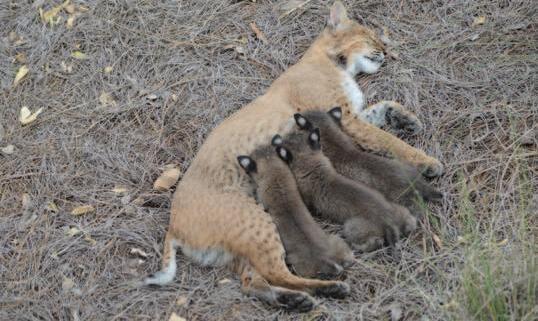
The Greers’ bobcat photograph collection exhibits a recurring theme: babies! Despite being fairly established in the coastal lowlands of South Carolina, bobcats are not often seen prowling neighborhoods. However, it appears the Seabrook porch and walkway have become a generational denning site for mothers and kittens. Jim Jordan, the Wildlife Biologist for Kiawah Island (a close neighbor of Seabrook Island), says it is quite possible that the cats in the photographs are related. “Bobcats rarely live more than five or six years on Kiawah,” says Jordan, “but female offspring tend to live in the same area as when they were born.” The cats will typically have one main den and several auxiliary dens within their home ranges.

In this award-winning photo, Hank believes he has captured a rare moment between father bobcat and kitten. The sheer size difference seems to indicate such, males being larger than females on average. “It is certainly possible that the bobcat in the photo is a male,” says Jordan, but it is not likely the father. Male bobcats will mate with several females during a breeding season and not stick around for kitten rearing. Regardless, the touching moment in this photograph shows the special connection between young and old.

Around the time when babies are about two months old, the female will go off to hunt, leaving the kittens vulnerable to predators. Laurel noticed that mom would protect the babies by hiding them under the Greers’ walkway. “The mother bobcat sometimes would bring back live rodents so the kittens could practice stalking and pouncing,” she says. Laurel notes that this behavior illustrates why it’s important not to feed wild animals. By playing with their food, the little ones can hone their hunting
skills. Kittens will remain with the mother until the following breeding season, venturing on their own usually by March.
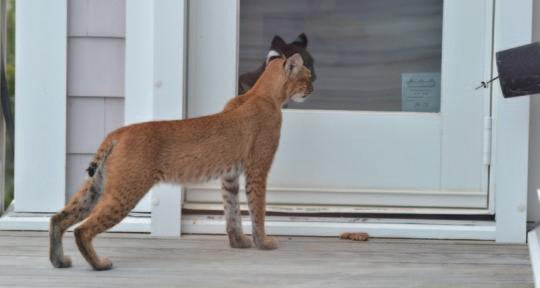
According to SCDNR, Bobcats are found in all the lower 48 states, and in South Carolina they are most heavily populated in the coastal plain. They may be common, but because of their terrific camouflage, stealthy instincts and human wariness they are rarely seen. In places like Kiawah and Seabrook, however, it appears the bobcat is adapting by finding homes in and around man-made structures. “On Kiawah, we have observed bobcats denning very close to homes for the last ten years,” says Jordan, “including several dens in the crawl space underneath homes.” He adds that the environmentally-friendly development of the island sets the stage for the unique dichotomy.
“They get very close,” says Laurel, even at one point coming up on the porch to look in the window at her pet cats. “It wasn’t an aggressive move,” Laurel says. “She didn’t appear hungry, just interested.”

In many respects, the wildcats endear themselves to people because of the similarities they share with domestic cats, but their untamed behavior sets them apart. The Greers love observing the bobcats, but do so from a respectful distance. As wild animals, Laurel believes that “any interference with them could take away their ability and desire to be self-sufficient.”
Bobcats remain one of South Carolina’s wild treasures, especially in the Lowcountry. They do not pose a great threat to people or agriculture and help to keep in check the population of rodents and other vermin. And, at the Greers’ home, they are welcomed guests. As spring comes around they will be waiting, cameraready, in hopes of another visit.

BY SARAH HUMLIE

HOW DO YOU IMAGINE CHARLESTON Animal Society in 2023? What services will they provide? How many animals will they help? What kind of challenges will they face? While it’s tough to predict the future, that’s the job tasked to a comprehensive group of stakeholders, made up of Board members, volunteers and staff, known as the Strategic Planning Committee. Commissioned by the Board of Directors at the request of Charleston Animal Society CEO, Joe Elmore, the 15-member committee’s work is to create a comprehensive five year plan for Charleston Animal Society that will outline what direction to take and where to invest resources to best he lp animals in the community going forward through 2023.
“We’ve been able to sustain a no-kill community in Charleston for the past five years thanks to focused, strategic use of our resources and efforts,” said Elmore. “Now it’s time for us to look around, gather input and reassess where it makes the most sense to direct our efforts for the next five years. We have to ask ourselves, how can we best accomplish our mission of preventing cruelty to animals? We want to make sure we have the focus and strategy to make the next five years as successful as the past five.”
The committee goes to great lengths to gather input from various stakeholders across the community, from the Board of Directors, staff and volunteers to adopters,
donors and constituents. Helen PrattThomas, Chair of the Strategic Planning Committee explains the process, “We combed through over 600 survey responses to get a sense of what the community saw as the biggest issues facing animals, and what they want to see Charleston Animal Society become in the future.”
“Dream big,” said Pratt-Thomas, “That’s our mantra. As long as the idea fits within our mission of preventing cruelty to animals, no idea is too big to consider.”
Beyond stakeholder input, the committee also conducts extensive research into the regional and national trends affecting animals and animal shelters. From published scientific studies, census numbers and interviews with statewide animal welfare leaders to ridealongs with Animal Control and the Sheriff’s Office, the committee gathers as much data as possible to build the Strategic Plan for Charleston Animal Society.
“It’s really important for our future plans to be based on sound data and placed in the context of the economic and political climate we face in South Carolina.” Elmore emphasizes. “While we don’t have a crystal ball that can predict the future with 100 percent accuracy, we can do our due diligence up front to try to prepare as much as possible for headwinds and circumstances the organization is likely to face.”
Pratt-Thomas further explains, “Our
environmental research into the issues helps us to winnow down the dreams and ideas shared with us at the beginning of this planning process by the greater community. We ask, what’s important to the community? Where do animals most need our help? And, what’s feasible for us to achieve over the next five years? Our research helps us confirm where the needs lie and helps us strategically direct our resources for the greatest impact.”
By the time the strategic plan is approved by the Board of Directors and published, the Strategic Planning Committee will have invested over nine months of effort into creating the document. “This will be Charleston Animal Society’s roadmap for the next five years,” Elmore said. “We wanted to take our time and do a thorough job of investigating where we’re going and how we’re going to get there.”
Pratt-Thomas anticipates the plan will be ready to present for Board approval in the spring of 2018. While the details of the plan have yet to be finalized, Pratt-Thomas asserts the process has made one thing clear, “This community really cares about the welfare of animals, big and small. They poured out their thoughts and concerns about animals and gave us a lot of ideas about what Charleston Animal Society can accomplish in the future. It’s going to be an exciting five years!”
How far would you go to adopt a pair of homeless dogs?
BY DAN KROSSE
PHOTOS BY CHARLES MERRY / CHARLESMERRY.COM
HURRICANE MARIA RIPPED into St. Croix, Nebraska National Guardsman Michael Henn was deployed to help the island with recovery efforts. Soon after his unit from Lincoln, Nebraska (the 67th MEB) arrived, Michael started working the overnight shift. “I was with two of my fellow soldiers one night, when we saw this white dog walk up to us. She was beautiful and we pet her and gave her treats,” Henn said.
They named her “Pumpkin” and as it turned out, Pumpkin had a friend, “Benji,” who also started visiting the soldiers. The national guardsmen were hooked. They went to the grocery store on their off-hours and bought soap and flea medicine and looked forward to Pumpkin and Benji’s visit every night. “We fell in love with them. We noticed they were happy together. A local told us the owners had passed away before the hurricane and the dogs had been abandoned,” Henn said. The soldier knew right then he had to rescue Pumpkin and Benji – and he knew he couldn’t take one without the other.
Henn’s efforts to get the dogs to Nebraska ran into several roadblocks: airline pet transport services were not running, the Air Force couldn’t help, and other agencies said “no,” until he contacted the ASPCA. Pumpkin and Benji went to the ASPCA emergency shelter on St. Croix and Henn crossed his fingers that somehow, the pair would make it back to the States together.
Christine Brugge is a dedicated worker at Charleston Animal Society, who usually manages the Feline Freedom Cat Sanctuary. But in November, she had volunteered to go help the ASPCA in St. Croix. Christine was the third employee Charleston Animal Society sent to help with hurricane relief

in the Virgin Islands. While working at the emergency shelter, Brugge heard a story about a pair of dogs who’d befriended some soldiers, but had no way back to the mainland.
A couple weeks into her volunteering stint, Brugge learned that Charleston Animal Society offered to take 30 dogs in a transport from St. Croix, to help them find new homes in Charleston. Brugge knew she had to get Pumpkin and Benji on that transport, but with almost 250 dogs in the emergency ASPCA shelter, Brugge had her work cut out for her. “Somehow, Christine was able to work her magic and make sure that Pumpkin and Benji were on that transport to Charleston,” said Charleston Animal Society Anti-Cruelty and Outreach Director Aldwin Roman.
When Pumpkin and Benji arrived in Charleston at 1:00am on November 30, Roman wasted little time emailing Henn.
The National Guardsman was elated and began planning his reunion with Pumpkin and Benji. On December 8, Henn left Lincoln on an epic 1,300 mile drive to Charleston to pick up the pair of dogs he couldn’t forget and bring them home to Nebraska.
“My stepmom and younger brother drove with me,” Henn said. “She drove the first leg, and I finished the 20-hour drive.”
The reunion, 20+ hours later, took place

in the lobby of Charleston Animal Society in front of a 12-foot Christmas Tree and there wasn’t a dry eye in the house. Media, members of the public and 20 staff showed up to watch as Henn saw Pumpkin and Benji make a beeline for him. “I tried not to smile so much, but I couldn’t help it,” said Henn. “The dogs were worth every second of that drive.”
“This soldier is an inspiration to all of us. Michael did everything he could to find these two animals a new home. Round trip, he actually drove 2,600 miles,” said Charleston Animal Society CEO Joe Elmore. “All of us can learn something from him.” Michael says he’s not the only one excited that Pumpkin and Benji are coming to Nebraska. Fellow National Guardsman are planning to make Pumpkin and Benji the unofficial mascots of the 67th MEB after they settle in, back in Lincoln.
The weather was perfect and the chili and oysters were delicious at the 2017 Chili Cook-off & Oyster Roast November 18th. Held at North Charleston’s Riverfront Park, this year's event saw 6,000+ people come through the gates. The cook-off raises money for Toby's Fund, Charleston Animal Society's medical fund that helps injured, abused and neglected animals.
Photography: Scott Guy and Tonya Brisson


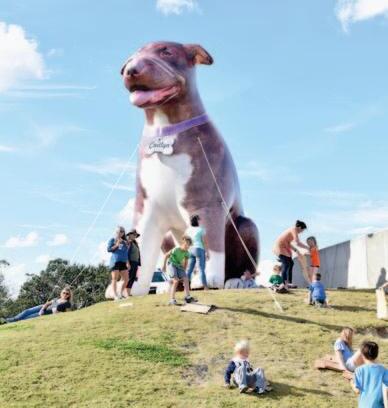
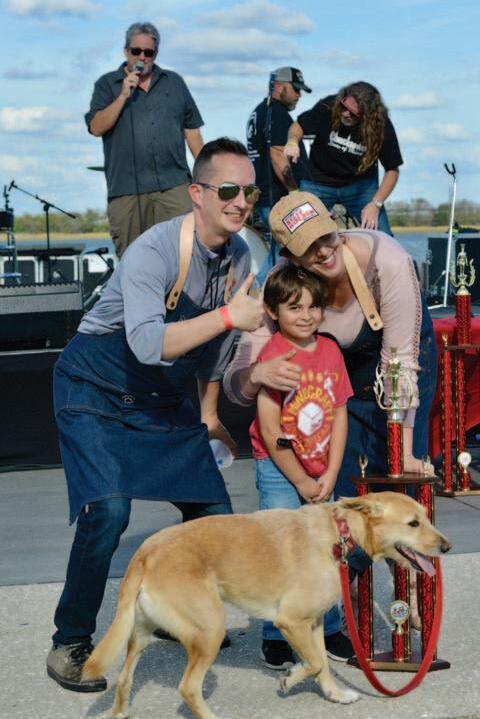

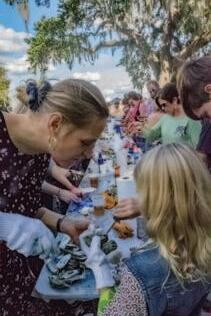


Charleston Animal Society in May of 2015, her body was broken, but her spirit shined through her eyes – those brown saucer-like eyes -- that could penetrate your soul with just one glance.
We are proud to announce that we’ve put her story together in a book, Caitlyn, America’s Dog. The book is dedicated to everyone connected to Caitlyn's rescue, treatment and recovery, as well as those who saw justice served, those who helped spread her story, and all those who helped by donating to Charleston Animal Society. Charleston Animal Society Board Member Peter Waters and Charleston Animal Society Director of Community Engagement Kay Hyman were instrumental in putting the book together,
Waters said it took about 13 months to compile all of the information for Caitlyn’s story, because there were so many articles from around the world. “It has been amazing to see how her story relates across all countries, ethnicities and ages,” Waters said. “Everyone is fascinated by her story that shows how people come together when they get upset by abuse like what she suffered.”
While Caitlyn's story is still being written, this book captures the most difficult part of her life -- her journey from abuse to recovery. Found with her muzzle taped shut with electrical tape, Caitlyn nearly died. But thanks to a community who cared, Charleston Animal Society, local veterinarians, detectives and prosecutors- Caitlyn's story became an inspiring story of triumph over adversity. This beautiful animal put a face on animal cruelty and in the process, she inspired people around the world.
When the tape that had been maliciously wound around her muzzle was removed, Caitlyn’s face blew up from swelling. Doctors worried that her tongue may have to be


removed because of the lack of oxygen she had suffered. But through it all she would look at you with those eyes and comfort you more than you could comfort her –everything will be OK – she seemed to say.
When Charleston Animal Society initially made the decision to share her story, we did so in the hopes of raising awareness of the animal cruelty that still impacts our society. Somehow and for some important reason, Caitlyn’s story connected with people around South Carolina, around the country and around the world. She became a social media phenomenon, she appeared on CNN, Fox News and the hashtag #IamCaitlyn went viral.
She became the voice for so many animals who do not have a voice. Animals that are abused, neglected and abandoned every single day. Her message was simple: This. Must. Stop. Her story made the issue of animal cruelty impossible to ignore. Charleston Animal Society could point to this case and encourage lawmakers, prosecutors, police and our friends and neighbors to demand that cruelty laws in South Carolina be enforced for all animals
Even humans found solace in Caitlyn’s bravery. Hyman received letters from women who suffered from domestic abuse. One wrote that she found the courage to leave her abusive situation after being inspired by Caitlyn. “The look in Caitlyn’s eyes evoked emotion Her story of hope and recovery has been instrumental in helping others to liberate themselves and animals from abusive situations,” said Hyman.
The man who did this to Caitlyn was eventually convicted and was given the maximum sentence for animal cruelty. And much of the reason is because Caitlyn could not, and would not be ignored. Her life mattered. The lives of every animal who falls victim to abuse matter.
When you purchase this book, you are helping future Caitlyns get the help they need through the Caitlyn Anti-Cruelty fund at Charleston Animal Society. We hope you enjoy this book and share it with your friends and family as a lesson to all of us about the power of good over evil. It is available at CharlestonAnimalSociety.org/ shop
More and more people are turning to marijuana-related products for their pets. Is that a good thing?
BY HELEN RAVENEL HAMMOND


Let’s get honest here. If your beloved pet had a serious illness or even a terminal disease, you would most likely do whatever it is in your power to make him/ her more comfortable- whether it be through clinical trials or trying the latest drug.
Take Eloise, for example. The eight-year-old English Bulldog had all the conditions an aging bulldog naturally gets- double hip dysplasia, knee problems, bilateral alopecia, hypothyroidism, dry eye, etc. She was on all kinds of medications, barely walking, not eating well, and her stomach was always upset from the medications.
Melissa Goodmon’s veterinarian recommended she try Cannabis oil (CBD), a liquid derived from the marijuana plant. Unlike THC, the high-inducing molecule in marijuana, CBD is not psychoactive. After much research, Goodmon found a marijuana dispensary (she lives in California, one of 29 states with laws broadly legalizing marijuana in some form). With her medical cannabis card, she started Eloise on her regimen.
Since then, Eloise has been off all “western meds.” That was more than a year ago.
“We’d already added acupuncture and a Raw diet. Her hair has grown back, she can walk up and down the stairs, go on short walks, has her energy and appetite back. Honestly, it’s been awesome,” says Goodmon.
Dr. Kellie Horton of Sun Dog Cat Moon Veterinary Clinic on Johns Island, says she has found cannabis to be extremely beneficial in patients with inflammatory issues. She has used it for pets with allergies, arthritis, neurological conditions, sometimes anxiety, even heart disease, depending on the type of cannabis and the milligrams.
“If I can, I will use the powder formula (dehydrated powder) or in the form of treats versus the oils,” she says, explaining that the oils have caused pancreatitis or GI issues with some patients.

These were the exact sentiments for Folly Beach residents and “Canna Bonez” founders Matt Mummert and Stacey Detlor.
When Stacey’s dog, Roscoe couldn't get up and down the steps, they began giving him homemade CBD-infused treats last April. The “old man” became spry again -- able to run, eat and play with other dogs. Canna Bonez came to fruition.
According to Matt, they have had a lot of positive feedback.
“People have been taking a more holistic approach for themselves and their furry friends, and CBD is as holistic as it gets! People are seeing all the benefits that CBD has to offer as hemp is becoming more culturally accepted.” Hemp is a sister plant to marijuana. While the plants are related, a person cannot get “high” on hemp because of its lack of THC. Hemp is legal in South Carolina.
Speaking of hemp, Dolittle’s in Charleston carries True Hemp chews and Releaf Hemp Oil. At an organic grocery store, Charleston resident, Holly Hadley recently discovered Pet Releaf Hemp Health Edibites. Her 12-year-old Sheltie/Lab mix, Reesie, had severe spondylosis from neck to tail and was prescribed multiple medications (Gabapentin, Methocarbamol, and Tramadol) to help treat her arthritis and chronic pain for years. When Reesie was diagnosed with the aggressive cancer, hemangiosarcoma, and given weeks to live, Hadley wanted to make sure that Reesie was as comfortable as possible.
“The Edibites seemed to help her with her overall mobility and ability to get comfortable with decreased restlessness. No negative effects were noted,” she said, commenting that she is glad to have added something to enhance her quality of life those last few months.
Jamye Hurteau wanted to see if the rage for hemp oil was all true. She started putting a touch of the oil on her 17-year-old Boykin’s gums. She thinks it’s prolonged his life in a positive way.
“There’s no set dosage for us with this oil for pets, so I’ve really been ‘medicating’ him, so to speak on my own,” says Hurteau.
This has been the complaint all along for those wary to administer or to try these CBD products. These products are not FDA-approved, and there has been no FDA evaluation of how they could interact with other drugs, or whether they have dangerous side effects or other safety concerns, according to the FDA website.
That’s why many veterinarians are squeamish to recommend or even talk about cannabis options.
Dr. Suzy Shannon, owner of Sweetgrass Animal Hospital, says, “The anecdotal evidence is promising for these substances, but it is difficult to recommend them because controlled studies have not yet been done. You cannot ask a dog or cat if they are experiencing side effects. Although our pets have human qualities, they have a different way of metabolizing substances; so we, as veterinarians, rely on studies to come up with a safe dose.”
Veterinarians’ reluctance doesn’t discourage people like Hurteau, “I know Snapper’s days are numbered. I would do whatever I could do to help him and what better way than something plant based and 100% natural?”
But even as the evidence that cannabis products could help your pets, experts say it’s always important to consult your veterinarian for an opinion. They know your pet’s health challenges better than anyone.


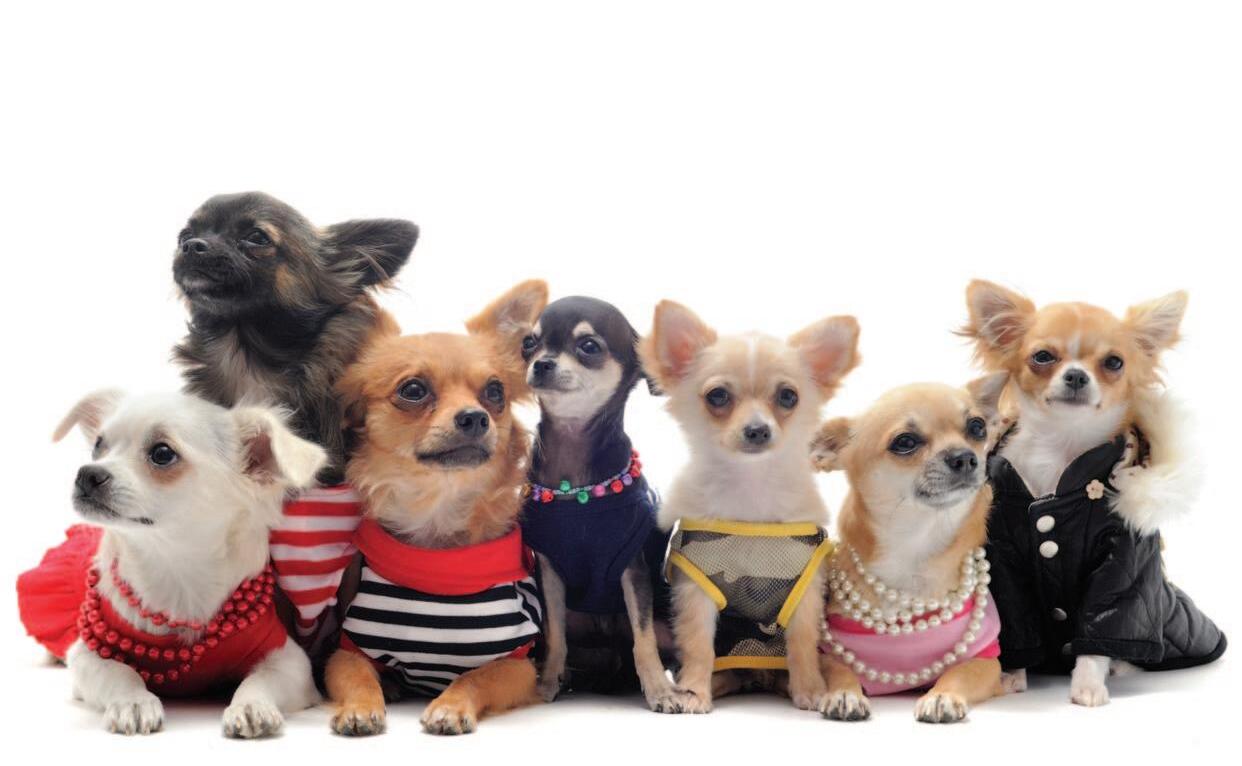
BY TERI ERRICO GRIFFIS
A BABY IN A WINTRY HAT AND mittens can make us all coo out loud, but the next cutest sight to see may be a puppy in a sweater or rain boots. But while it’s adorably entertaining—is it necessary? An expert at Charleston Animal Society weighs in on what pets really need during inclement weather.
“Pets don’t need winter clothes because they normally wouldn’t be putting themselves in situations that would make them necessary,” says Angele Bice, DVM, Director of Veterinary Care at Charleston Animal Society. She notes that in poor weather, pets would take care of themselves by finding shelter and steering clear of rain or cold—or coming indoors. She adds that most animal attire, short of Thunder Jackets which are medically useful, exist simply because owners find them aesthetically pleasing. And there’s no harm in that!
Of course, all dogs are different in how
much cold—or even heat—they can withstand and their coats have varying thicknesses and lengths. “Depending on the breed, some dogs, like Huskies or Pomeranians, are quite insulated with extra intra-abdominal fat and thicker coats that help them keep warm longer. Other dogs, like Italian Greyhounds, have little body fat and thin short coats and can get cold more easily.” Bice adds, “If you have a very lean dog with a short, thin coat, that will need to be outside for a long period of time, then a coat may be helpful.”
For the most part, however, if it’s too cold for you to stay outside, it’s time to bring your dog inside, as well. “Dogs should be outside in the cold for the same length of time their owners are comfortable being outside with them. If it is too cold for you, it is probably too cold for your pet,” Bice says. Dogs that have proper shelter
available to them can usually do all right in cold con ditions. They need a space that’s small enough and enclosed enough to allow them to retain the body heat, block the wind, and keep out moisture. It also helps to have a proper place to lay down that absorbs their heat rather than retain the cold temperatures.
As for the question of whether or not dog boots are made for walking, the answer is: maybe!
“Dogs have a thicker callus like paw pad that helps protect against rough surfaces and to some degree the weather,” Bice explains. “If conditions are extreme though, their feet can be damaged. Walking outside to use the bathroom in the snow would not be a problem, but walking on ice for hours could cause frost bite.”
When in doubt, let nature be your guide (rather than your fashion sense) for the dos and don’ts of dressing up your pet.
BY HELEN RAVENEL HAMMOND
YOU’D THINK PETS CAN’T GET OUT of a vet’s office fast enough! Well Carolina Tails found several who actually want to stay, and in fact, live at the clinic.
Meet Larry a t West Ashley Veterinary Clinic:
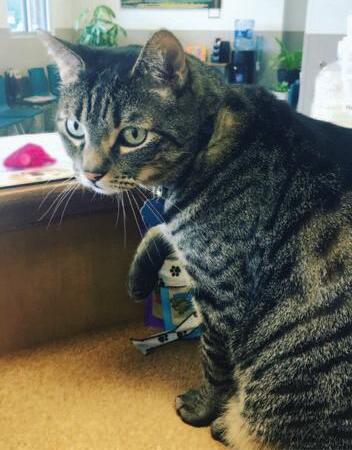
Larry might meet or greet you before a staff member has a chance. For five years, this cat has lounged on the receptionist’s counter playing with the printer while curiously waiting for the next client. First thing in the morning, Larry (a.k.a. “Sir
Lawrence of West Ashley” or “Lardimus”) likes to lie on the warming pad in the treatment center. He also enjoys opening bags of cat and dog food and eating it—his catnip addiction is not to be ignored!
Larry even has his own Instagram account, @lunchroom_larry where he is spreading #emptybowlsyndromeawareness. This cat loves to eat!
Meet Eddie at Animal Medical Center:
For as long as most patients have been going to Animal Medical Center in Mt. Pleasant, there has been a golden retriever behind the desk to greet them. First there was Otis, and now for the past 11 years, Eddie has been saying hello. Both dogs belong to the founder of the vet practice, Dr. Scott Senf.
“Nothing flusters Eddie. When he senses one of our staff members is stressing, he will go put his head in their lap,” Senf says. “It’s amazing.”
Eddie loves his routine. He “works” Mondays, Tuesdays and Thursdays, with Wednesdays and Fridays off. His “rounds” include a trip to each worker to say hello (with a pretty obvious pass by each office cookie jar), before taking up residence behind the front desk.
Meet Fred at Riverbank Veterinary Clinic
Fred was brought to Riverbank Veterinary Clinic on Johns Island as a stray—and three years later, he hasn’t left. “He's quite an old man and he's a hot mess. He is hypothyroid, FIV positive, deaf and has chronic cruddy ears. He also drools when you pet him,” explains Lindsay Simmons, Customer Service Representative, Social Media Coordinator, and Veterinary Technician. That might explain Fred’s extended stay. He is allowed to wander the clinic early in the morning and during lunch, but during normal hours he is in his room or snoozing in the doctor's office and is kept away from other kitties.
He has also been plotting his "great escape" to the outside for years (and will try to make a run for it out the front doors if given the chance). "We are still holding on to hope that he will find a loving forever home as we know he'd be much happier having free roam of a house, but we are glad to have him here and have grown quite attached," Simmons says.


BY ELLIE WHITCOMB PAYNE
A mutt and his heroic journey make it to the big screen in the springtime animated film Sgt. Stubby: An American Hero.
The tale of Sergeant Stubby is the stuff of legend: heroism, loyalty and epic battle scenes! This year, 100 years after Stubby embarked to the frontlines of World War I, Fun Academy Motion Pictures will introduce a new generation to this unassuming pit bull, and how he became the United States Army’s most decorated dog.
The notably lengthy obituary of Sergeant Stubby appeared in the New York Times in April 1926 and related a fantastic war story already familiar to most Americans of the time. The author describes with affection (and a bit of artistic flair) Sergeant Stubby’s greater feats throughout his 210 days on the Western Front.
In one battle, Stubby and his adopted master, Corporal Robert Conroy, along with their compatriots, endured 24 hours of gas

attack. After recovering, it was said that the war dog became sensitive to the mustard gas and would bark out warnings before an onslaught. The obituary recounts how Stubby surprised a German spy, seized the “prisoner by his breeches… and held on until help arrived.” Reportedly, Stubby would stand watch tirelessly and brave the ravaged battlefield leading paramedics to wounded men.
The Army formally acknowledged his courage, promoting him to Sergeant, and thus he became the first American war dog to be given rank in the United States Armed Forces, according to the Americans at War exhibit at Smithsonian National Museum of American History.
In addition to his courage, Stubby must have been a charming character. Soldiers and officers embraced the pup readily, despite breaking more than a few regulations. After wandering onto a training field, the stray
won over soldiers by learning bugle calls and drills, and would remain as the mascot for the 102nd Infantry, 26th Division, even with a ban on animals in camp. Today, the Smithsonian exhibit describes how, when discovered aboard the SS Minnesota, Stubby was allowed to stay after addressing Conroy’s commanding officer with a proper salute. He was a friend to the unit through four major offensives and, after the war, his network grew. Stubby was introduced to three U.S. presidents and was honored personally by General John Pershing, Commander of the American Expeditionary Force in which Stubby served.
Look in theaters this April for the canine who captivated America and helped to console a country recovering from one of the deadliest wars in its history. Sgt. Stubby: An American Hero promises to be a heartwarming flick for all ages and a reminder that heroes come in all sizes.



No matter how much we love our pets, there’s always the chance they will run into a legal situation. Attorney David Aylor took time to answer questions from our readers in this edition of Ask a Lawyer. Send your questions to: CarolinaTails@CharlestonAnimalSociety.org.

QUESTION: Hi David, my friend's cat became too much for them to handle and they gave her to me. I gladly took this beautiful Siamese off their hands! I have had her microchipped, vaccinated and provided her a warm and loving home for the past two months. Now, my friend wants the cat back to give back to the breeder for a refund! I am heartbroken and do not want to give her up. Do I have to?
-- Cody, Meggett
DAVID AYLOR: You may not have to give the Siamese back. If your friend gave you the cat as a “gift” then the cat is legally yours. However, even if your friend did not officially gift the cat to you, you may recover your expenses for microchipping and vaccinating the cat, because of your reliance on your friend’s promise.
QUESTION: I went to a local park to walk my dog. I parked my car and as I was getting out, I popped the hatchback and my dog flew out and got into a tussle with another dog that was approaching my car off a leash. He thought the dog was approaching us too closely. My dog always waits for me to get to him and leash him up before getting out, but this time was different. I immediately apologized to the other owner and put my
dog back in. Neither dog was hurt. But I wondered if her dog was injured, would I be liable? What could happen?
--Cindy, Daniel Island
DAVID AYLOR: Dogs are similar to other property. If your dog injured her dog, then she could bring a claim against you for the medical expenses of her dog.
QUESTION: My neighbor is talking about euthanizing her dog because of behavior issues the dog is having such as jumping on young children. I have offered some suggestions and am very worried she will follow through and have the dog euthanized. Would I be in trouble if I steal the dog to save its life?
--Paul, Moncks Corner
DAVID AYLOR: Yes, if you steal the dog it would be considered theft, so it could result in a criminal charge. However, you could contact the Humane Society, inform them of the situation, and let them handle it. The State Legislature has made the theft of all domesticated ani mals, and even animals which have in any degree been subjected to the control of any owner, a crime.


If you have a legal question regarding pets, write us at CarolinaTails@CharlestonAnimalSociety.org and we will try and get it answered for you.
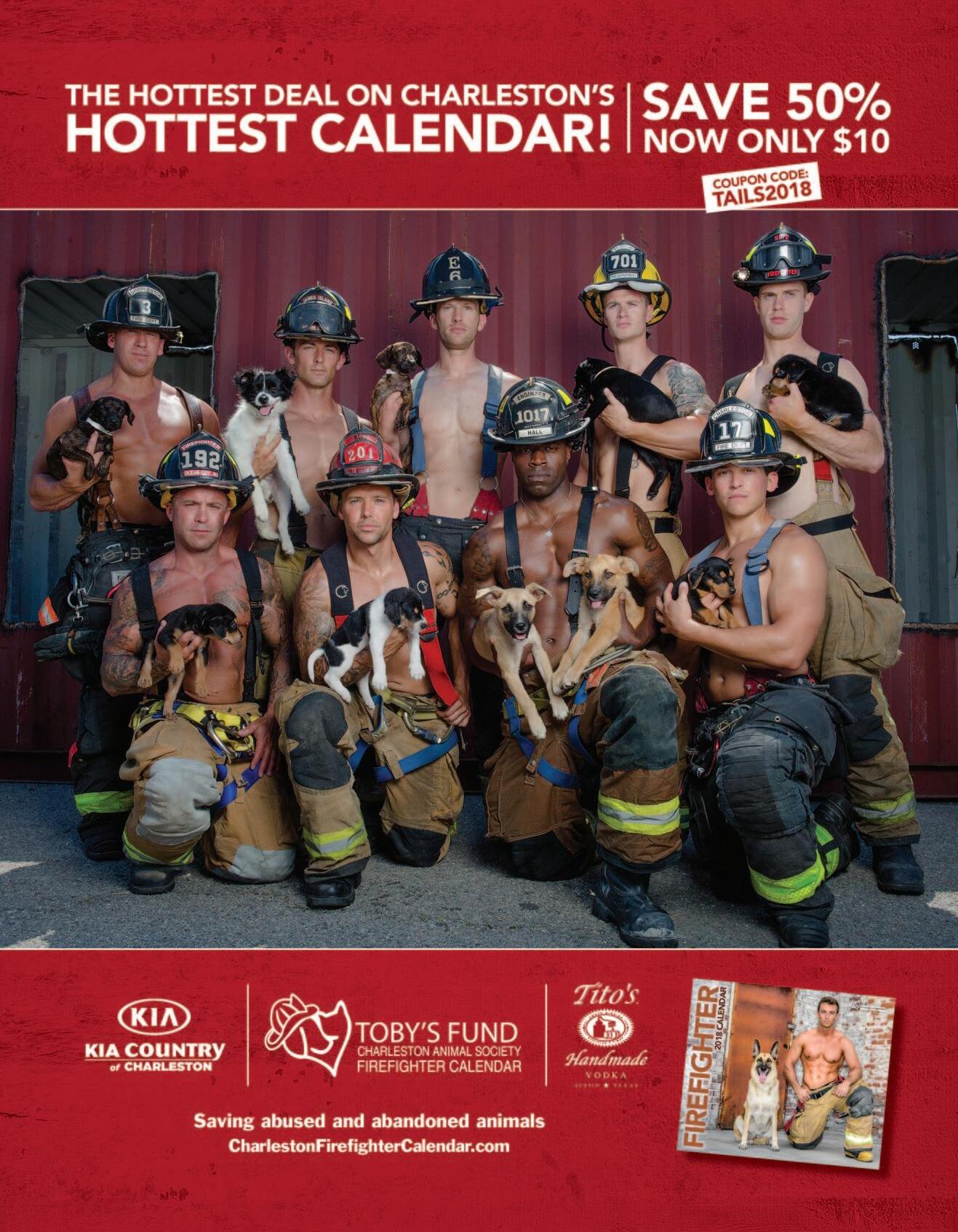

Saddleback Mobile Veterinary Service (843) 718-4299
Mobile
All Creatures Veterinary Clinic (843) 579-0030
224 Calhoun St, Charleston, SC 29401
Patrick Veterinary Clinic (843) 722-4470
667 Meeting St, Charleston, SC 29403
Charleston Harbor Veterinarians (843) 410-8290
280 Rutledge Ave, Charleston, SC 29403
Olde Towne Veterinary Clinic (843) 723-1443
17 Pinckney St, Charleston, SC 29401

Air Harbor Veterinary Clinic (843) 556-5252
1925 Savannah Hwy, Charleston, SC 29407
Bees Ferry Veterinary Hospital (843) 769-6784
3422 Shelby Ray Ct, Charleston, SC 29414
West Ashley Veterinary Clinic (843) 571-7095
840 St Andrews Blvd, Charleston, SC 29407
Animal Care Center (843) 556-9993
1662 Savannah Hwy #135, Charleston, SC 29407
Animal Medical West (843) 766-7387
704 Orleans Rd, Charleston, SC 29407
Charleston Veterinary Referral Center (843) 614-8387
3484 Shelby Ray Ct, Charleston, SC 29414
VCA Charles Towne Animal Hospital (843) 571-4291
850 Savannah Highway Charleston, SC 29407
Banfield Pet Hospital (843) 766-7724
2076 Sam Rittenberg Blvd, Charleston, SC 29407
Animal Hospital of North Charleston (843) 352-8404
8389 Dorchester Rd, North Charleston, SC 29418
Lowcountry Pet Wellness Clinic (843) 556-7387
5900 Rivers Ave, Unit D-1, North Charleston, SC 29406
Veterinary Specialty Care (843) 793-2161
3163 West Montague Ave, North Charleston, SC 29418
Dorchester Veterinary Hospital (843) 552-0259
5617 Dorchester Rd, North Charleston, SC 29418
Coastal Carolina Veterinary Specialists (843) 747-1507
3163 W Montague Ave, North Charleston, SC 29418
Charleston Heights Veterinary Clinic (843) 554-4361
2124 Dorchester Rd, North Charleston, SC 29405
Northwoods Veterinary Clinic (843) 553-0441
8320 Rivers Ave, North Charleston, SC 29406
The Animal Hospital of North Charleston (843) 608-8948
8389 Dorchester Rd, North Charleston, SC 29418
Banfield Pet Hospital (843) 797-4677
7620 Rivers Ave, Charleston, SC 29406
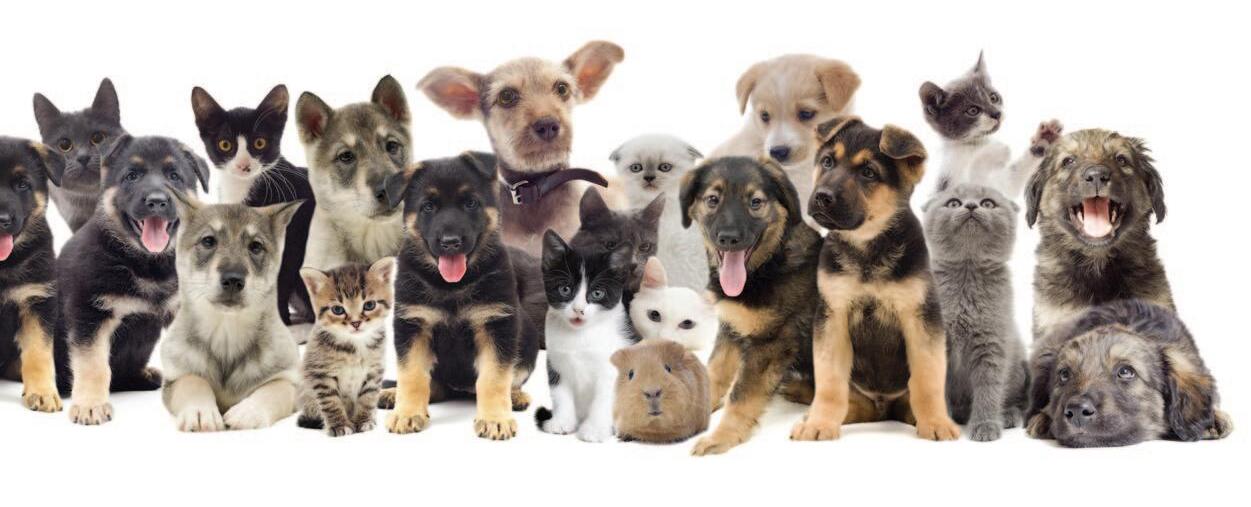
Charleston Animal Society and Carolina Tails want to always promote the best habits for animal care possible and seeing your veterinarian regularly is key to having a happy, healthy animal.
Exotic Vet Care (843) 216-8387
814 Johnnie Dodds Blvd, Mount Pleasant, SC 29464
East Cooper Animal Hospital (843) 884-6171
993 Johnnie Dodds Blvd, Mount Pleasant, SC 29464
Island Veterinary Care (843) 628-1941 Mobile
Mount Pleasant Animal Hospital (843) 884-4921
1213 Ben Sawyer Blvd, Mount Pleasant, SC 29464
Pet Vet Animal Hospital (843) 416-9304
307 Mill St, Mount Pleasant, SC 29464
Shuler Animal Hospital (843) 884-4494
1769 Highway 17 N, Mount Pleasant, SC 29464
Veterinary Specialty Care (843) 216-7554
985 Johnnie Dodds Blvd, Mount Pleasant, SC 29464
Advanced Animal Care of Mount Pleasant (843) 884-9838
3373 S Morgans Point Rd, Mount Pleasant, SC 29466
Animal Eye Care of the Lowcountry (843) 881-2242
1131 Queensborough Blvd Suite 100, Mount Pleasant, SC 29464
Animal Medical Center of Mt. Pleasant (843) 881-5858
958 Houston Northcutt Blvd, Mount Pleasant, SC 29464
Cats Only Animal Hospital (843) 849-1661
1492 B North Highway 17, Mount Pleasant, SC 29464
Long Point Animal Hospital (843) 971-7701
757 Long Point Rd, #B, Mount Pleasant, SC 29464
Lowcountry Cat Practice (843) 884-7966
1184 Highway 41, Mount Pleasant, SC 29466
Palmetto Veterinary Hospital (843) 881-9915
2443 Hwy 17 N, Mount Pleasant, SC 29466
Park West Veterinary Associates Park West Veterinary Associates
Simply Spay & Neuter (843) 856-9190
1054-C Johnnie Dodds Blvd, Mount Pleasant, SC 29464
Southeast Veterinary Dermatology & Ear Clinic (843) 849-7770
1131 Queensborough Blvd Suite 100, Mount Pleasant, SC 29464
Tidewater Veterinary (843) 856-7300
1964 Riviera Dr Suite G, Mount Pleasant, SC 29464
Banfield Pet Hospital (843) 971-7460
911 Houston Northcutt, Mount Pleasant, SC 29464
Banfield Pet Hospital (843) 971-7460 (843) 388-1701
676 Long Point Rd, Mount Pleasant, SC 29464
Sandy Cove Veterinary Clinic (843) 885-6969
1521 Palm Blvd, Isle of Palms, SC 29451
Folly Road Animal Hospital (843) 762-4944
1038 Folly Rd, Charleston, SC 29412
Charleston Veterinary Care (843) 789-3222
51 Windermere Blvd, Charleston, SC 29407
Maybank Animal Hospital (843) 795-3131
1917 Maybank Hwy, Charleston, SC 29412
Oceanside Veterinary Clinic (843) 795-7574
1509 Folly Rd, Charleston, SC 29412
Sea Islands Veterinary Hospital (843) 795-6477
1310 Camp Rd, Charleston, SC 29412
James Island Veterinary Hospital (843)795-5295
756 Folly Rd, Charleston, SC 29412
Banfield Pet Hospital (843) 406-8609
520 Folly Rd, Charleston, SC 29412
Pet Helpers Spay and Neuter Clinic (843) 302-0556
1447 Folly Rd, Charleston, SC 29412
Angel Oak Animal Hospital (843) 559-1838
3160 Maybank Hwy, Johns Island, SC 29455
Bohicket Veterinary Clinic (843) 559-3889
3472 Maybank Hwy, Johns Island, SC 29455
Johns Island Animal Hospital (843) 559-9697
1769 Main Rd, Johns Island, SC 29455
Riverbank Veterinary Clinic (843) 277-2250
2814 Maybank Hwy, Johns Island, SC 29455
Southside Animal Hospital (843) 556-6969
3642 Savannah Hwy Suite 176 West Ashley Place, Johns Island, SC 29455
Sun Dog Cat Moon (843) 437-0063
2908 Maybank Hwy, Johns Island, SC 29455
Daniel Island Animal Hospital (843) 881-7228
291 Seven Farms Dr, Daniel Island, SC 29492
Lowcountry Home Vet (843) 406-2997 Mobile
Creekside Veterinary Clinic (843) 824-8044
431-G St. James Ave, Goose Creek, SC 29445
Mt. Holly Veterinary Clinic (843) 405-7765
113 St. James Ave, Goose Creek, SC 29445
Animal Medical Clinic of Goose Creek (843) 569-3647
102 Central Ave, Goose Creek, SC 29445
Goose Creek Veterinary Clinic (843) 553-7011
501 Redbank Rd. Goose Creek, SC 29445
Best Friends Animal Clinic (843) 414-7455
1000 Tanner Ford Blvd, Hanahan, SC 29410
Hanahan Veterinary Clinic (843) 744-8927
1283 Yeamans Hall Rd, Hanahan, SC 29410
College Park Road Veterinary Clinic (843) 797-1493
186 College Park Rd, Ladson, SC 29456
Lowcountry Pet Hospice and Home Euthanasia (843) 640-9755
Mobile
Sangaree Animal Hospital (843) 494-5121
1665-A N Main St, Summerville, SC 29486
Sangaree Animal Hospital at Cane Bay (843) 494-5121
1724 State Rd, Unit 5D, Summerville SC 29486
Banfield Pet Hospital (843) 832-0919
470 Azalea Square Blvd, Summerville, SC 29483
Flowertown Animal Hospital (843) 875-6303
1401 Bacons Bridge Rd, Summerville, SC 29485
Westbury Veterinary Clinic (843) 873-2761
1497 W 5th North St, Summerville, SC 29483
Central Veterinary Hospital (843) 851-2112
1215 Central Ave, Summerville, SC 29483
Shambley Equine Clinic (843) 875-5133
122 Kay Ln, Summerville, SC 29483
Knightsville Veterinary Clinic (843) 851-7784
478 W Butternut Rd, Summerville, SC 29483
Nemasket Veterinary Clinic (843) 871-4560
605 Miles Rd, Summerville, SC 29485
Oakbrook Veterinary Clinic (843) 871-2900
1705 Old Trolley Rd, Summerville, SC 29485
Sweetgrass Animal Hospital (843) 225-9663
9730 Dorchester Rd Suite 101, Summerville, SC 29485

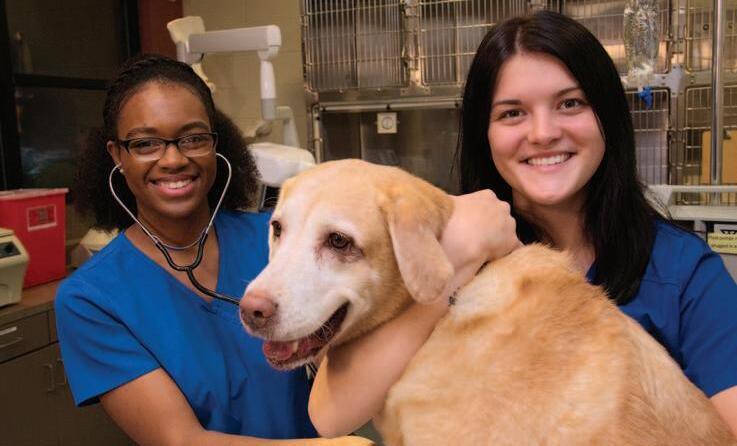
MEGAN YOUNG, LVT, HAS ALWAYS had a passion for working with animals and was offered a job at a veterinary clinic right out of college. As her career grew, so did her desire for further education, and she found the veterinary technology program she was seeking at Trident Technical College.
When she started the program, she found a brand-new facility set up just like a hospital. Under the tutelage of Dr. Paul Kerwin, the students would take in shelter animals and be taught how to work with them “hands on.”
Ashley Spangler, LVT, graduated from the program in 2012—but started with zero veterinary clinic experience. She had a previous 10-year career in tourism and hospitality. Burned out from her job and following her love for animals, Spangler started the program.
“Considering I knew nothing going in and walked away with experience and a job says a lot,” comments Spangler. Both Spangler and Young are employed at busy vet clinics in the Charleston area.
The role of a veterinary technicians is similar to a veterinarian in that they can share many of the same responsibilities, except they cannot diagnose, prescribe or perform surgery. Common tasks performed by veterinary technicians include taking medical histories, providing treatment for routine problems and counseling clients. They draw blood, collect urine, and perform skin scrapings and routine lab procedures and tests. Veterinary technicians also administer medications, anesthesia and blood products to the animals as prescribed by the veterinarian, as well as dress wounds, take vital signs, clean teeth and take radiographs. They commonly assist veterinarians in surgery and maintain treatment records and inventory of all pharmaceuticals, equipment and supplies. They are an integral part to every veterinary clinic.
Noelle Blaney, Marketing Coordinator at
Trident Technical College, explains that the Vet Tech Program started in 2001. Currently, there are three other accredited vet tech programs in the state.
“There’s a lot of interest and community support for our program. The full-time program is filled for Fall of 2018, and students are now being placed in Fall 2019,” Blaney says.
Pamela Barnes is the Vet Tech Club President and a big fan of Trident’s veterinary tech program. “They take you from knowing nothing about animals to giving you everything you need to know to pass the vet tech licensing exam—and to be successful in your career.”
Students say the program is affordable and offers flexible class schedules and helpful and well-trained faculty. If you love working with animals, enjoy science, solving problems and helping others, look no further than Trident Tech’s Veterinary Tech Program.

It’s a brand new year, and we have some gorgeous animals to show you in this edition of “Take Me Home!” Make 2018 a year to remember, with a new furry family member. Come see us at 2455 Remount Road in North Charleston or visit: www.CharlestonAnimalSociety.org.
Dog Photography: Jeanne Taylor / JTPetPics.com; Cat Photography: Marie Rodriguez / MarieRodriguezPhotography.com

Hello, I’m Parker, and still hanging in my New Year’s Eve tux. Why don’t you come by Charleston Animal Society and let's take in 2018 together?

Hi I’m Apollo. I’m pretty mellow, love to hang and get into some occasional mischief. How about “swiping right” for me?

They call me Johnny around these parts. I’m a black lab mix and always up for an outdoor adventure. Please come visit me, so we can plan our next hike.

My name is Gertie. I’m looking for a family that will let me run my kitten circles all over the place and make you laugh. Let’s visit!

Hi I’m Legolas, and I ain’t nothing but a hound dog. If you’ve never caught a rabbit, you're still a friend of mine.
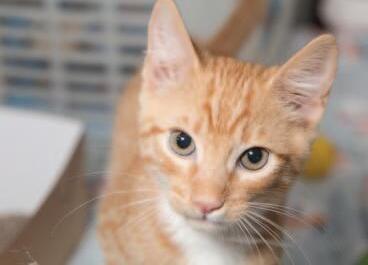
Hi I’m Andy. This shelter is awesome, but I can only imagine how much more awesome it would be to have my own place to call home. Forever.

name
Zoe
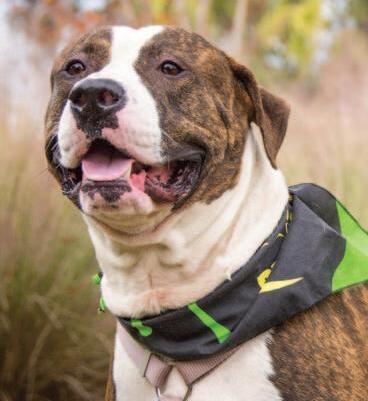
My name is Plymouth and I’m looking forward to all the fun I’m going to have with my new family in 2018. All I need right now is my new family. Could that be you?
The 2018 Firefighter Calendar is on sale now! The calendar made its debut to a packed house at Memminger Auditorium in the fall. Order your calendar at CharlestonFirefighterCalendar.com.
Photography: TagYourPix.com and Tom Galloway



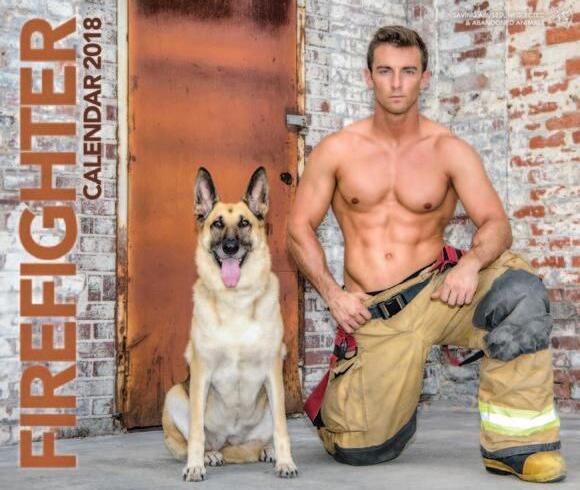


BY TERI ERRICO GRIFFIS
Two people meet. They fall in love. They share a home. But before moving in together, there are questions all couples need to ask: Where should we live? How many kids should we have? What temperature can we agree on for the thermostat? There’s also another important question: What about pets? Just like the Brady Bunch had to blend their (human) children, some couples have to figure out how to blend their fur kids—or decide if they want any at all. Sometimes it works, and sometimes it doesn’t! See how these families figured it out.

Samantha and David Spooner have a happy home—but it’s a unique one! When the couple decided to tie the knot, David’s daughter joined them in their new house, and so did his Corgi, Bubbles, and Sam’s rescue mutt, Ginger. It was a peaceful first two years, but over time, the dogs increasingly began snapping and barking at each other. The once serene space became a breeding ground for aggression and Ginger and Bubbles now live separate lives—but the compromise is, it’s in the same house.
“There was no way I was getting rid of my dog and Bubbles is such a good dog, it wasn’t her fault Ginger would snap at her,” Samantha explains. “So we have an elaborate gate system and divide the house to keep the dogs in separate areas.”
The canine relationship started out peacefully with the family walking them on leashes, feeding them at the same time and also offering them equal treats. There was a time when both dogs also slept in Samantha and David’s bed together. But throw in the fact that Ginger, a possible German ShepherdLab mix, had always been a little feisty with other dogs and Bubbles was a jealous little furball, and you get a recipe for disaster. Ginger would chase a ball and Bubbles would trip her up. A chair would move and startle Ginger and she would snap thinking Bubbles was antagonizing her. “It used to be just once in a while issues, but soon it became they couldn’t be together at all,” Samantha says. “So we gate the stairs and one dog typically stays upstairs and one stays downstairs.”
Separate corners have worked great for the family, and the dogs swap who goes where or who gets to play outside. “Typically when we’re home, Bubbles stays in a room with us and Ginger has free roam of the house and they’re happy,” Samantha adds. “But you do what you have to, to make things work and keep everyone together. And this works—for now!”
The McKenzies are no stranger to animals. Growing up in a rural area, they both had dogs—and horses and goats and pigs. But as they picture their future with a cozy house and a big yard, the two couldn’t disagree more on what type of pet should be their first. Glenn would prefer a Doberman or a Greyhound, while Margaret wants a King Charles Spaniel.
“When I was born, my parents bought a Doberman and I was really attached to it,” Glenn says. “I’ve always wanted to adopt another and was even thinking a Greyhound or something in that vein.”
Margaret, however, had other thoughts, and most of them having to do with a cute, smaller breed. “She grew up with larger breeds, too, typically mutts, and while I could deal with a smaller dog—I like cute little dogs as much as the next guy—that’s definitely not my first choice,” Glenn says with a laugh.
While he doesn’t object to a smaller “fuzzball,” Glenn knows that financially they can often cost more to adopt and care for. “But we do live in an apartment where a big dog isn’t practical either,” he notes. So where’s the compromise?
Glenn sees two options. “In the end, if I put any puppy in front of her that is sweet and gentle and adorable, she’ll love it,” he says, no matter the breed “Or we’ll just have to get multiple dogs which I’m OK with also!” We guess we’ll have to wait and see what happens!

Before moving in together, Leah and Terry Murphy decided on a trial run. No, not to see if Terry cleaned up after himself or if Leah was a nagging roommate. The goal was to find out if her two cats, Riley and Maddie, and his large dog, Chewie, could get along. “There were a couple nights when Terry brought Chewie over to my apartment to see how he acted around the cats—and to make sure he wouldn’t try to eat them alive, which is what we were both worried about!” Leah recalls with a laugh. Things went pretty well. Chewie didn’t get overly excited and the cats only became aggressive if he came too close.
Feeling optimistic, the Murphys moved in together and transformed the loft above their garage into the cats’ own safe space, as a precaution. A baby gate at the bottom of the stairs served as a barrier. Over time, the household meshed so peacefully that the Murphys confidently added to their brood. Not only were they blessed with a baby boy last year, but they adopted another dog and two kittens to grow to a family of eight (Maddie recently passed away). Best of all, since the new additions and baby Aiden are growing up around Chewie and Riley, they all get along pretty famously. “The cats will curl up and sleep around the dogs or rub against them and the dogs are so good with them. They all love each other.” Leah describes, “It’s a little bit of a zoo around here, but it’s a lot of fun.”
Pet Boarding & Daycare
Creekside Pet Retreat27 Paw Plaza Hotel16
Pet Cremation & Burial Services
Pet Rest 15
Pet Friendly Housing
Brackenbrook
Crickentree



Kids are some of the best animal advocates so we’ve devoted this space to young pet lovers.




